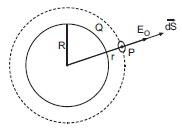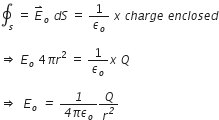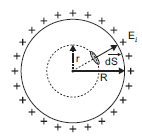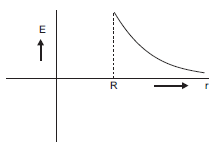Using Gauss’ laws deduce the expression for the electric field due to a uniformly charged spherical conducting shell of radius R at a point (i) outside and (ii) inside the shell.
Plot a graph showing variation of electric field as a function of r > R and r < R. (r being the distance from the centre of the shell).
i) Consider a uniformly charged thin spherical shell of radius R carrying charge Q. To find the electric field outside the shell, we consider a spherical Gaussian surface of radius (r >R), concentric with given shell. If E is electric field outside the shell, then by symmetry electric field strength has same magnitude E0 on the Gaussian surface and is directed radially outward.
So, electric flux through Gaussian surface is given by, ![]()
Therefore, ![]()
Charge enclosed by the Gaussian surface is Q.
Therefore, using gauss’s theorem, we have
Thus, electric field outside a charged thin spherical shell is the same as if the whole charge Q is concentrated at the centre.
ii) Electric field inside the shell:
The charge resides on the surface of a conductor. Thus, a hollow charged conductor is equivalent to a charged spherical shell. Let’s consider a spherical Gaussian surface of radius (r < R). If E is the electric field inside the shell, then by symmetry electric field strength has the same magnitude Ei on the Gaussian surface and is directed radially outward.
Electric flux through the Gaussian surface is given by, ![]()
= ![]()
Now, Gaussian surface is inside the given charged shell, so charge enclosed by Gaussian surface is zero.
Therefore, using Gauss’s theorem, we have
Thus, electric field at each point inside a charged thin spherical shell is zero.
The graph above shows the variation of electric field as a function of R.
